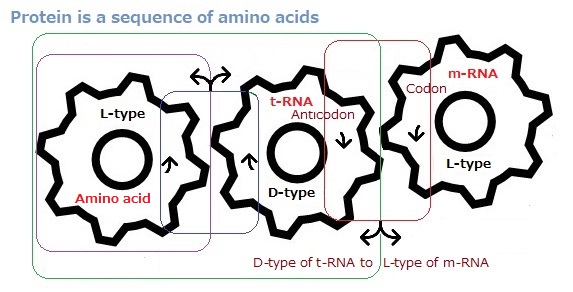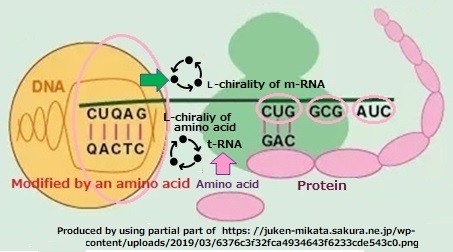7.4 Producion of homochirality biomolecules at a cell membrane
The change in free energy when hydrogen and oxygen atoms form covalent
bonds is -50~-110 kcal/mol. The energy of hydrogen bonds and ionic bonds
is in the range of 3~7 kcal/mol. The binding energy of the van der Waals
bond is 1~2 kcal/mol. The energy of thermal motion at 25°C is 0.6 kcal/mol,
but the range of energy of thermal motion is large, and there are many
molecules with kinetic energies that break the energy of hydrogen bonds
and ionic bonds. Liquid water molecules repeatedly disappear to form intermolecular
bonding tissues. The thermal motion of the racene structure in the name
of its liquid water is involved in vital activity.
L-type (right-handed type) of amino acids invade cell membranes, moreover the same typeof amino acids invade in succession. When amino acid molecules of the same chirality makes peptide binds, spiral-shape or ribbon-shape proteins are produced, which easily detach from the cell membrane. D-shaped (right-handed) region occurs in which amino acids swirl and touch the periphery of the protein-making region, and the gears rotate in opposite directions as if meshing.
The surface is combined with a long chain of carbohydrates containing
D-type monosaccharides, forming a row of molecules containing D-type monosaccharides.
L chirality of amino acids with type and type D nucleic acids
are generated synchronously. The molecules that are elements of the structure
of the spiral do not mix molecules with different chirality.

Fig.15 Mechanism of protein replication using different chirality.
7.5 Formation of t-RNA and m-RNA for replication of protein
The change in free energy when hydrogen or oxygen atoms form covalent bonds is
-50~-110 kcal/mol。 The energy of hydrogen and ionic bonds is in the range of 3~7 kcal/mol. The binding energy of the van der Waals bond is
1~2 kcal/mol. The energy of thermal motion at 25°C is 0.6 kcal/mol, but the range of energy of thermal motion is large.
There are many molecules with kinetic energy that break the energy of hydrogen bonds and ionic bonds.
Liquid water molecules repeatedly disappear to form intermolecular bonding tissues. The thermal motion of the spiral structure in the name of its liquid water is involved in vital activity.
A glycose and D-type region is generated in which amino acids swirl and
touch the periphery of the protein-making region, and the gears rotate
in opposite directions as if meshing. A row of long-chain carbohydrates
containing D-type monosaccharides produced on a surface swirling in the
opposite direction is produced to produce t-RNA that carries amino acids.
In this way, living organisms on Earth are composed of proteins whose chirality is composed of sugars of the right-hand system (D-type ) and amino acids of the left hand system (L-type). DNA, which stores genetic information, has a double spiral structure, with one strand being a right-handed symmetric molecular sequence and the other being a left-handed symmetry molecular sequence. Each molecular sequence has a different function.

Fig.16 Structure of cell membranes that produce proteins in a water
environment
7.6 Mechanism of protein replication using DNA
When L-type amino acids invade the cell
membrane, the same L-type amino acids invade in succession. When amino
acid molecules of the same chirality bind peptide, spiral-shaped or ribbon-shaped
proteins are generated, which easily detach from the cell membrane. D-shaped
(right-handed) region occurs in which amino acids swirl and touch the periphery
of the protein-making region, and the gears rotate in opposite directions
as if meshing. The surface is combined with a long chain of carbohydrates
containing D-type monosaccharides, forming a row of molecules containing
D-type monosaccharides. Amino acids with L-type (right-handed) chirality
and D-type nucleic acids are generated synchronously. The molecules that
are elements of the structure of the racene do not mix molecules with different
chiralities.
A glycos and D-type region is generated in which amino acids swirl and
touch the periphery of the protein-making region, and the gears rotate
in opposite directions as if meshing. A row of long-chain carbohydrates
containing D-type monosaccharides produced on a surface swirling in the
opposite direction is produced to produce t-RNA that carries amino acids.
In this way, living organisms on Earth are composed of proteins whose chirality
is D-type of sugars and L-type of amino acid system. DNA, which stores
genetic information, has a double racene structure, with one strand being
a right-handed symmetric molecular sequence and the other being a left-handed
symmetry molecular sequence.

Fig.17 Mechanism of protein replication using DNA
to index -7.2-